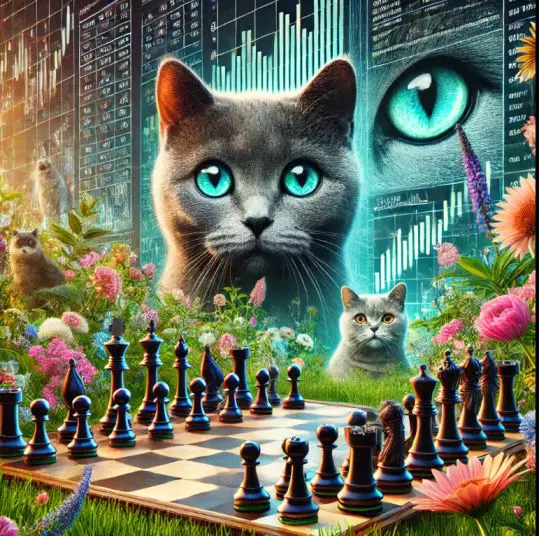
Greenspan Put: Rates Won’t Rise Soon
Updated Oct 30, 2024
Introduction:
Spill your latte, stain your silk tie, and wake up to the bitter truth—the market is a beast that feeds on the faint-hearted. It’s time to embrace the fierce, the fearless, and the incredibly wealthy. While the meek inherit the Earth, the bold conquer the markets.
Forget the gentle whispers of conventional wisdom; we’re here to shout, challenge, and conquer. The name of the game is not passive acceptance but aggressive dominance. The market is a battlefield, and we’re about to unleash Sun Tzu’s art of war on it.
Proposition: The Greenspan Put is not a relic of the past but a sleeping dragon waiting to be awakened by the brave. It’s time to challenge the notion that interest rates are beyond our control and harness the power of this ancient weapon for modern gains.
The Modern Greenspan Put: Dancing with Devils in Pin-Striped Suits
In the savage arena of modern finance, the Greenspan Put has evolved from a mere historical footnote into a ferocious beast that protects and devours. Welcome to 2024, where the legacy of Alan Greenspan’s market-saving mechanisms has morphed into something far more potent and dangerous than its creator ever imagined.
The New Dance of the Markets
Gone are the days when central banking was a genteel profession practised by academic economists in peaceful rooms. Under Jerome Powell’s leadership, today’s Federal Reserve wields unprecedented power in markets that have become addicted to monetary stimulus. With interest rates hovering around 5.25-5.50% – levels unseen in decades – we’re witnessing a high-stakes game of chicken between the Fed and market forces.
The Devil’s Bargain: Understanding Both Sides
Let’s rip away the veil of politeness and expose the raw truth of the modern Fed Put. On the positive side, this mechanism creates a safety net that is so powerful that it can turn market corrections into buying opportunities that would make Gordon Gekko salivate. When markets tumble, the Fed’s implicit promise to intervene creates a self-fulfilling prophecy of recovery. Smart money doesn’t fight the Fed; it front-runs it with the precision of a heat-seeking missile.
But here’s where it gets deliciously dangerous. This protective mechanism has created a distorted market that makes a funhouse mirror look straight. The negative consequences are like a slow-acting poison in the financial system’s bloodstream. We’re breeding generations of investors who’ve never known true market price discovery, creating zombie companies that shuffle along on cheap credit, and building a house of cards that grows taller with each intervention.
The Art of War in Modern Markets
In this battlefield, survival demands understanding the protective and destructive forces at play. When markets convulse, the Fed Put acts as a shock absorber, preventing cascading failures that could trigger another 1929. It’s a seductive safety net that allows institutional players to take massive positions with the confidence of a trapeze artist working with a net.
But make no mistake – this protection comes at a price. The system now carries so much structural risk that when (not if) it finally breaks, the resulting carnage could make 2008 look like a warmup act. We’re creating economic distortions that would make Keynes himself reach for the whiskey bottle.
Riding the Beast: Strategic Implementation
For those brave enough to dance in this Thunderdome, the opportunities are massive. When markets crater, that’s your signal to start buying with both hands. The Fed Put means major corrections are increasingly likely to be followed by robust recoveries. It’s financial physics—what goes down must come up as long as the Fed maintains its protective stance.
But here’s the twist that separates the winners from the body bags: You need to play both sides of this beast. When everyone’s drinking the Kool-Aid of endless market support, that’s precisely when you should be building your defensive positions. The smartest predators in this jungle know that the Fed Put isn’t a guarantee – it’s a probability game with nuclear-sized consequences.
Expanded Overview: The Greenspan Put – A Financial Safety Net and Its Implications
The “Greenspan Put” is a term that originated during Alan Greenspan’s tenure as Chairman of the Federal Reserve from 1987 to 2006. This term refers to the Federal Reserve’s perceived policy of lowering interest rates and injecting liquidity into the market during periods of financial crisis. This policy effectively created a safety net for investors, acting as a symbolic “put option,” a financial instrument that allows holders to sell assets at an agreed price, thereby protecting against falling prices.
One notable example of the Greenspan Put in action was during the 1997 Asian Financial Crisis. Under Greenspan’s leadership, the Federal Reserve lowered interest rates, providing much-needed liquidity to the markets. This action was seen as a move to shield investors from the full impact of the crisis, functioning similarly to how a put option would.
Another instance was during the Dot-com bubble burst in 2000. The Federal Reserve again lowered interest rates to stimulate economic growth and prevent a full-blown financial crisis. This move was seen as another example of the Greenspan Put, reinforcing the perception of the Federal Reserve’s role as a protector of financial markets.
However, the Greenspan Put has been subject to criticism. While it provided short-term market stability, this strategy has been criticized for encouraging excessive risk-taking by creating an expectation of Federal Reserve intervention during downturns. Critics argue that this policy may have contributed to subsequent financial crises, including the 2008 financial crisis, by fostering a culture of moral hazard among investors.
The Psychology of Modern Markets
Mass psychology in today’s market is a force that would fascinate Freud himself. We’ve created a generation of investors conditioned to buy every dip, whether shallow or deep. This Pavlovian response creates predictable patterns that skilled players can exploit. But beware—this same psychology can turn on a dime when fear overwhelms greed.
The Path Forward: A Warning and an Opportunity
As we navigate through 2024 and beyond, the Fed Put remains the most powerful force in modern markets. It’s a tool of mass financial destruction and creation, capable of both saving the system and potentially destroying it. Success requires understanding this duality and positioning yourself accordingly.
The smart money knows this isn’t your grandfather’s market anymore. The rules have changed, but the game remains eternal: Make money when you can, preserve capital when you must, and never forget that the market is a cruel mistress who cares nothing for your beliefs or opinions.
In conclusion, the modern Greenspan Put is both a saviour and destroyer, protection and poison. Those who survive and thrive in this environment will be the ones who understand its dual nature and respect its awesome power. The rest will wonder what hit them when the music finally stops.
Remember, in this game of financial musical chairs, there are no prisoners, only survivors. Play accordingly.
Random suggestions
Lastly, we suggest living below your means and putting your money to work in the stock market. Mass Psychology knows no limits and can help you spot trends in any market, allowing you to protect yourself and benefit from these new trends. Remember, disaster is just a code word for opportunity.
Subscribe to our free newsletter to keep abreast of the latest developments; we cover everything from the financial markets to the World’s food supplies.
Other Articles of Interest














